The Best QA Tools & Browser Extensions You Should Be Using Right Now
Your QA toolkit can make or break your testing efficiency. This guide covers the best browser extensions and tools for manual and automation testers—battle-tested, QA-approved, and built for smarter testing.
